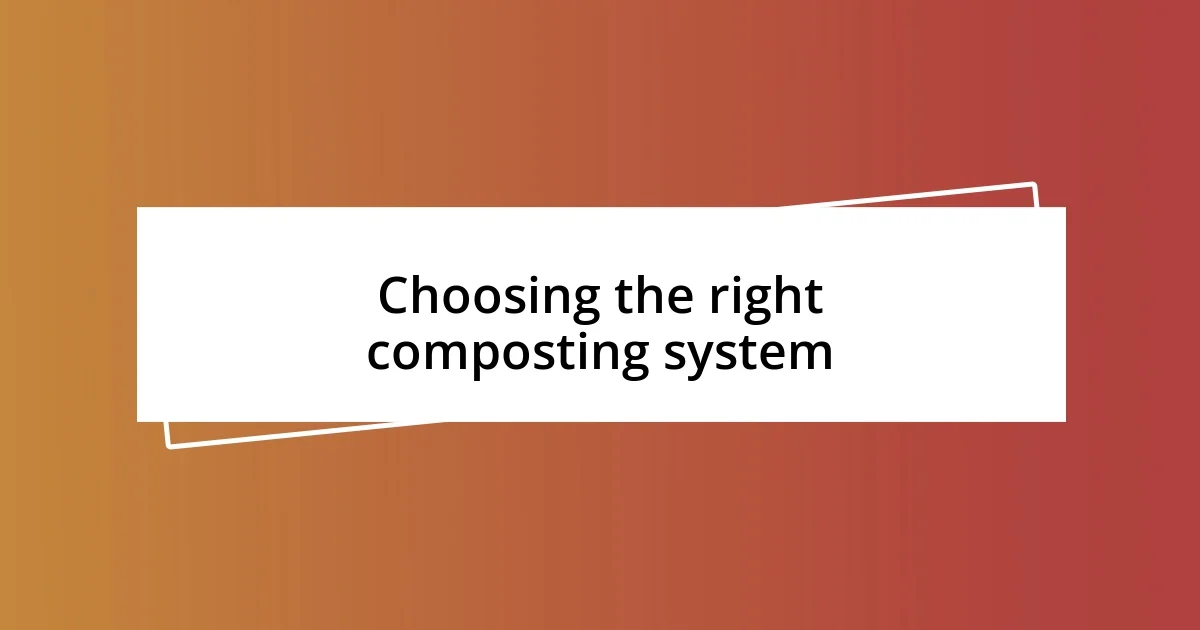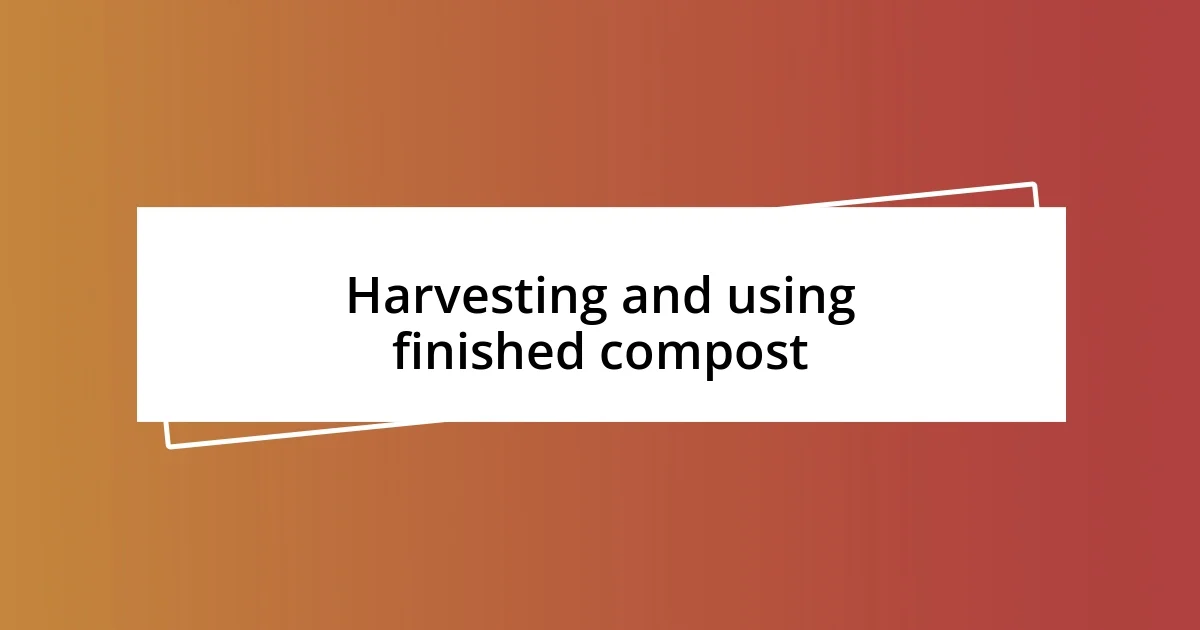Key takeaways:
- The article emphasizes the significance of choosing the right composting method based on available space, type of waste, and maintenance commitment, which enhances the overall composting experience.
- It highlights the importance of balancing green and brown materials in the compost while also educating on what materials to avoid to prevent issues like odor and pests.
- The benefits of home composting include reducing kitchen waste, saving on fertilizers, and fostering a deeper connection with nature through the composting process.

Understanding home composting methods
When I first dabbled in home composting, I felt utterly confused by the sheer range of methods available. From traditional heap composting, where you simply pile up materials, to the more sophisticated worm composting (or vermicomposting), each method has its own charm and effectiveness. Have you ever thought about how the method you choose can influence not just the speed of composting, but also the quality of the finished product?
One method that really resonated with me is the bokashi system, which involves fermenting kitchen scraps in an anaerobic environment. I remember the moment I discovered its ability to handle dairy and meat scraps—something conventional composting struggles with. It felt like unlocking a secret door to sustainable living. It made me wonder, if we all found ways to reduce waste in our kitchens, how much could we transform our environment?
I’ve also explored layered composting, where you alternate brown materials like dried leaves with green materials like vegetable scraps. Initially, I wasn’t sure why layering was so vital until I realized that it’s all about creating the right airflow and balance. Seeing those layers transform over time filled me with a sense of accomplishment—could composting really be a reflection of our personal growth? The journey through these different methods is not just about waste reduction; it’s about nurturing the earth and ourselves in return.

Choosing the right composting system
Choosing the right composting system truly impacts not only the efficiency of the process but also how enjoyable it can be. When I settled on a small bin for my apartment, I was initially skeptical. I remember pondering whether it would handle my food scraps without becoming a smelly mess. To my delight, the compact design encouraged me to experiment more with different scraps, and before long, I was lovingly tending to my little ecosystem.
Here are some factors I consider essential when selecting a composting system:
- Space Available: Assess how much room you have for a composting setup, whether it’s a small bin, heap, or worm farm.
- Type of Waste: Determine what materials you’ll be composting; some systems handle everything, while others are more limited.
- Maintenance Commitment: Think about how much time you can dedicate to the process. Some methods require more attention than others.
- Odor Management: Consider systems that mitigate smells, which can be a concern especially in urban settings.
- Climate Consideration: Your local weather can influence efficiency; certain systems work better in warmer or cooler climates.
The journey of composting can be tailor-made to suit your lifestyle and preferences. I learned that I could enjoy the entire process more when I chose a method that fit seamlessly into my daily life. Whether you are an enthusiast or just getting started, finding the right system can lead to unexpected joys, like watching my plants thrive thanks to the nutrient-rich compost I carefully nurtured.

Materials suitable for composting
When it comes to materials suitable for composting, I often think of the perfect balance between green and brown items. Green materials like vegetable scraps, coffee grounds, and grass clippings are rich in nitrogen, which fuels the composting process. In contrast, brown materials, such as dried leaves, cardboard, and straw, provide carbon, which is essential for healthy microbial activity. I learned early on that not all materials decompose at the same rate, so finding that sweet spot between the two can really speed things up and enhance the quality of the compost. Have you ever noticed how certain household items transform the compost pile?
Another thing that struck me was the surprising variety of kitchen waste I could compost. At first, I was hesitant about including items like egg shells and certain fruits, but experimenting with these materials turned out to be rewarding. I remember the excitement I felt when I discovered that even citrus peels can be composted, as long as they’re in moderation due to their acidity. This realization opened my eyes to the potential of turning perceived “waste” into a valuable resource for my garden. It’s incredible how much richer my compost became by including these overlooked ingredients.
Lastly, I’ve come to appreciate the importance of knowing what not to compost. Items like meat, dairy, and oily foods can attract pests and create unpleasant odors. There was this one time I forgot to remove leftover pizza crusts, and the smell that followed was just horrifying! It served as a valuable lesson. By sticking to safe materials and avoiding problematic products, I’ve been able to maintain a thriving compost that not only benefits my plants but also gives me peace of mind. Understanding which materials contribute positively to composting is key for anyone looking to embark on this eco-friendly journey.
| Material Type | Examples |
|---|---|
| Green Materials (Nitrogen-rich) | Vegetable scraps, coffee grounds, grass clippings |
| Brown Materials (Carbon-rich) | Dried leaves, cardboard, straw |
| Items to Avoid | Meat, dairy, oily foods, citrus (in moderation) |

Troubleshooting common composting problems
Composting can sometimes feel like a delicate dance, and I’ve certainly stumbled along the way. One of the biggest problems I faced was my compost pile getting too wet. It was discouraging to see my efforts turning into a soggy mess! I learned that adding more brown materials—like shredded newspaper or dry leaves—helped balance moisture and improved aeration. Have you ever found yourself overwhelmed by too much moisture? It’s a quick fix that can save your compost!
Another issue I encountered was odor. It’s amazing how quickly an unpleasant smell can pop up if you include the wrong materials or if the compost isn’t aerated enough. There was one night I opened my bin to a whiff that reminded me of a rotting fruit market! I realized that stirring the compost regularly not only helped combat odors but also mixed the layers for better decomposition. Ask yourself: how often do you turn your compost? A little TLC goes a long way!
Finally, pests can be a real headache. At one point, I returned home to find unwelcome visitors snacking on my compost — raccoons! I had to change my approach and invest in a compost bin with a secure lid. It was a game changer! I reflected on how important it is to protect not just my compost, but also the critters outside that enjoy our scraps. These experiences taught me that composting isn’t just about breaking down waste; it’s about creating a harmonious environment for all. Have you faced any challenges in keeping pests at bay?

Tips for maintaining healthy compost
Maintaining healthy compost involves a few simple yet effective strategies. First, I found that regular turning of the compost not only aerates it but allows me to monitor its progress closely. I remember the first time I stirred my pile; it felt like discovering a hidden treasure! Each shift revealed those rich, dark layers forming underneath—I was so excited to see the transformation. How often do you check your compost?
Moisture balance is another critical aspect. One summer, I got a bit too enthusiastic with my watering, and the compost turned into a smelly stew. The lesson there was clear: keeping a consistency in moisture—not too dry but not overly wet—is vital for healthy decomposition. I learned to use my hands to gauge the moisture, aiming for a crumbly texture instead of a soggy mess. Have you ever had that panic moment when you realize your compost is not thriving?
Lastly, adding diverse materials keeps the compost lively and nutrient-rich. I like to mix in kitchen scraps daily, but I also learned to toss in crushed eggshells and coffee filters—who knew they could be so beneficial? Each ingredient contributes something unique, which makes monitoring the compost a fascinating experience. Have you considered what variety can do for your compost’s health? Exploring these dynamics has made my composting journey both rewarding and educational!

Harvesting and using finished compost
Harvesting finished compost is like uncovering a hidden gem in your yard. When I first started, I was amazed by the transformation from kitchen scraps to this rich, dark, crumbly material. It felt like tangible proof of my effort, and I remember the first time I used it in my garden—it was nothing short of exhilarating. Do you remember your first harvest? It’s not just compost; it’s the result of nurturing what some may deem waste into something truly valuable.
As I began to use my finished compost, I noticed how much my plants thrived. I sprinkled it into my flower beds, and within days, the difference was noticeable. Flowers bloomed brighter, and vegetables seemed to grow overnight! It might sound cliché, but seeing those vibrant colors and robust growth filled me with a sense of pride. Have you ever experienced such a rewarding moment with your plants? It reminds me that this practice isn’t just environmentally friendly; it’s a way to reconnect with nature.
While it’s easy to get caught up in the excitement of harvesting, I realized that proper application is crucial, too. I learned to incorporate compost into the soil rather than just laying it on top, ensuring its nutrients are fully utilized. I also started using it as a top dressing for my pots, which seemed to work wonders. The joy of watching my garden flourish with my homemade compost made all those earlier challenges worth it. What will you try in your space with your finished compost?

Benefits of home composting practices
Home composting offers a laundry list of benefits that can make a significant difference in both your garden and the environment. For me, one standout advantage is the sheer reduction of kitchen waste. Every time I dump scraps into my compost bin, I feel a sense of relief knowing I’m diverting potential trash from a landfill. Have you ever thought about how much waste you produce daily? Just knowing I’m contributing to environmental sustainability brings me a profound sense of satisfaction.
Another benefit I cherish is the cost-effectiveness of composting. Rather than purchasing expensive fertilizers, I now create my own nutrient-rich compost. Reflecting on the first time I tested my homemade compost on my vegetable garden, it felt like I was giving my plants a homemade meal—one rich in all the good stuff. Their vibrant response was a rewarding validation of my effort. I wonder, how much could you save by composting instead of fertilizing?
Moreover, cultivating a compost pile fosters a deeper connection with nature. It’s not merely a chore; for me, it has become a meditative experience. I remember those moments spent turning the compost and watching its transformation—time seemed to slow down. It reminds me that I’m part of a larger cycle of life. Have you experienced that moment of mindfulness while working with your compost? These moments enrich my life in ways I never expected, making home composting a practice I deeply value.














